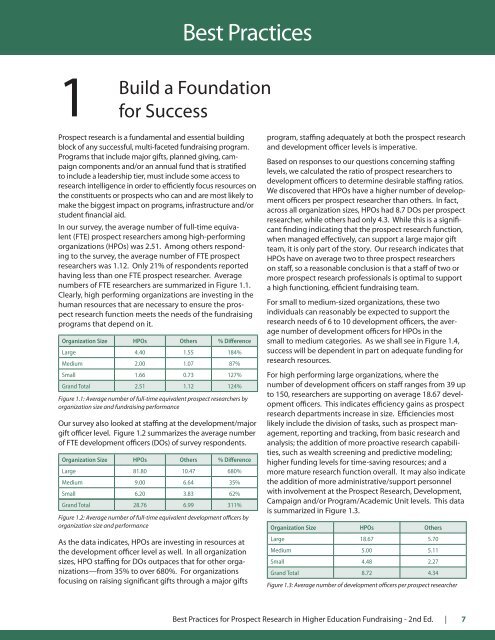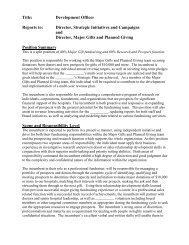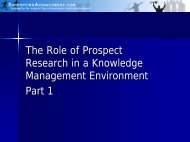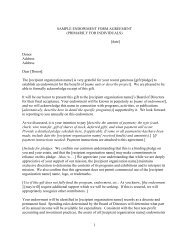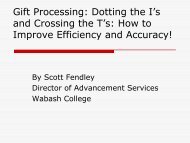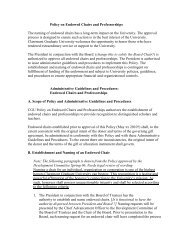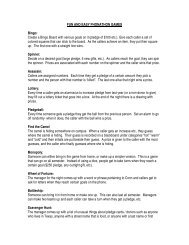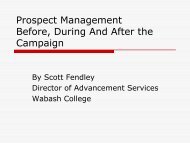WealthEngine Best Practices in Higher Education for Prospect ...
WealthEngine Best Practices in Higher Education for Prospect ...
WealthEngine Best Practices in Higher Education for Prospect ...
You also want an ePaper? Increase the reach of your titles
YUMPU automatically turns print PDFs into web optimized ePapers that Google loves.
<strong>Best</strong> <strong>Practices</strong><br />
1<br />
Build a Foundation<br />
<strong>for</strong> Success<br />
<strong>Prospect</strong> research is a fundamental and essential build<strong>in</strong>g<br />
block of any successful, multi-faceted fundrais<strong>in</strong>g program.<br />
Programs that <strong>in</strong>clude major gifts, planned giv<strong>in</strong>g, campaign<br />
components and/or an annual fund that is stratified<br />
to <strong>in</strong>clude a leadership tier, must <strong>in</strong>clude some access to<br />
research <strong>in</strong>telligence <strong>in</strong> order to efficiently focus resources on<br />
the constituents or prospects who can and are most likely to<br />
make the biggest impact on programs, <strong>in</strong>frastructure and/or<br />
student f<strong>in</strong>ancial aid.<br />
In our survey, the average number of full-time equivalent<br />
(FTE) prospect researchers among high-per<strong>for</strong>m<strong>in</strong>g<br />
organizations (HPOs) was 2.51. Among others respond<strong>in</strong>g<br />
to the survey, the average number of FTE prospect<br />
researchers was 1.12. Only 21% of respondents reported<br />
hav<strong>in</strong>g less than one FTE prospect researcher. Average<br />
numbers of FTE researchers are summarized <strong>in</strong> Figure 1.1.<br />
Clearly, high per<strong>for</strong>m<strong>in</strong>g organizations are <strong>in</strong>vest<strong>in</strong>g <strong>in</strong> the<br />
human resources that are necessary to ensure the prospect<br />
research function meets the needs of the fundrais<strong>in</strong>g<br />
programs that depend on it.<br />
Organization Size HPOs Others % Difference<br />
Large 4.40 1.55 184%<br />
Medium 2.00 1.07 87%<br />
Small 1.66 0.73 127%<br />
Grand Total 2.51 1.12 124%<br />
Figure 1.1: Average number of full-time equivalent prospect researchers by<br />
organization size and fundrais<strong>in</strong>g per<strong>for</strong>mance<br />
Our survey also looked at staff<strong>in</strong>g at the development/major<br />
gift officer level. Figure 1.2 summarizes the average number<br />
of FTE development officers (DOs) of survey respondents.<br />
Organization Size HPOs Others % Difference<br />
Large 81.80 10.47 680%<br />
Medium 9.00 6.64 35%<br />
Small 6.20 3.83 62%<br />
Grand Total 28.76 6.99 311%<br />
Figure 1.2: Average number of full-time equivalent development officers by<br />
organization size and per<strong>for</strong>mance<br />
As the data <strong>in</strong>dicates, HPOs are <strong>in</strong>vest<strong>in</strong>g <strong>in</strong> resources at<br />
the development officer level as well. In all organization<br />
sizes, HPO staff<strong>in</strong>g <strong>for</strong> DOs outpaces that <strong>for</strong> other organizations—from<br />
35% to over 680%. For organizations<br />
focus<strong>in</strong>g on rais<strong>in</strong>g significant gifts through a major gifts<br />
program, staff<strong>in</strong>g adequately at both the prospect research<br />
and development officer levels is imperative.<br />
Based on responses to our questions concern<strong>in</strong>g staff<strong>in</strong>g<br />
levels, we calculated the ratio of prospect researchers to<br />
development officers to determ<strong>in</strong>e desirable staff<strong>in</strong>g ratios.<br />
We discovered that HPOs have a higher number of development<br />
officers per prospect researcher than others. In fact,<br />
across all organization sizes, HPOs had 8.7 DOs per prospect<br />
researcher, while others had only 4.3. While this is a significant<br />
f<strong>in</strong>d<strong>in</strong>g <strong>in</strong>dicat<strong>in</strong>g that the prospect research function,<br />
when managed effectively, can support a large major gift<br />
team, it is only part of the story. Our research <strong>in</strong>dicates that<br />
HPOs have on average two to three prospect researchers<br />
on staff, so a reasonable conclusion is that a staff of two or<br />
more prospect research professionals is optimal to support<br />
a high function<strong>in</strong>g, efficient fundrais<strong>in</strong>g team.<br />
For small to medium-sized organizations, these two<br />
<strong>in</strong>dividuals can reasonably be expected to support the<br />
research needs of 6 to 10 development officers, the average<br />
number of development officers <strong>for</strong> HPOs <strong>in</strong> the<br />
small to medium categories. As we shall see <strong>in</strong> Figure 1.4,<br />
success will be dependent <strong>in</strong> part on adequate fund<strong>in</strong>g <strong>for</strong><br />
research resources.<br />
For high per<strong>for</strong>m<strong>in</strong>g large organizations, where the<br />
number of development officers on staff ranges from 39 up<br />
to 150, researchers are support<strong>in</strong>g on average 18.67 development<br />
officers. This <strong>in</strong>dicates efficiency ga<strong>in</strong>s as prospect<br />
research departments <strong>in</strong>crease <strong>in</strong> size. Efficiencies most<br />
likely <strong>in</strong>clude the division of tasks, such as prospect management,<br />
report<strong>in</strong>g and track<strong>in</strong>g, from basic research and<br />
analysis; the addition of more proactive research capabilities,<br />
such as wealth screen<strong>in</strong>g and predictive model<strong>in</strong>g;<br />
higher fund<strong>in</strong>g levels <strong>for</strong> time-sav<strong>in</strong>g resources; and a<br />
more mature research function overall. It may also <strong>in</strong>dicate<br />
the addition of more adm<strong>in</strong>istrative/support personnel<br />
with <strong>in</strong>volvement at the <strong>Prospect</strong> Research, Development,<br />
Campaign and/or Program/Academic Unit levels. This data<br />
is summarized <strong>in</strong> Figure 1.3.<br />
Organization Size HPOs Others<br />
Large 18.67 5.70<br />
Medium 5.00 5.11<br />
Small 4.48 2.27<br />
Grand Total 8.72 4.34<br />
Figure 1.3: Average number of development officers per prospect researcher<br />
<strong>Best</strong> <strong>Practices</strong> <strong>for</strong> <strong>Prospect</strong> Research <strong>in</strong> <strong>Higher</strong> <strong>Education</strong> Fundrais<strong>in</strong>g - 2nd Ed. | 7


